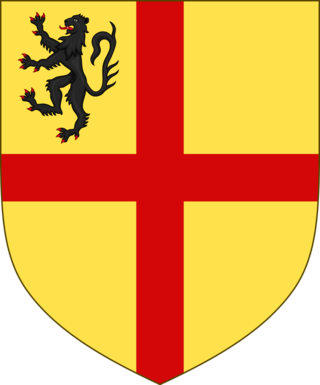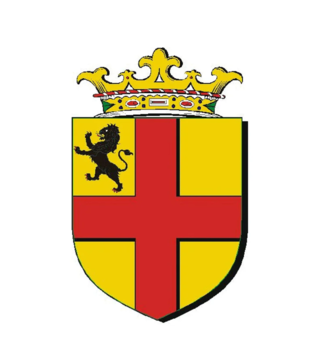
Earl or Lord of Clanricarde is a title that has been created twice in the Peerage of Ireland, first in 1543 and again in 1800. The former creation became extinct in 1916 while the 1800 creation is extant and held by the Marquess of Sligo since 1916.

Sir Uilleag (Ulick) de Burgh (Burke), 1st Clanricarde or Mac William Uachtar was an Irish chieftain and noble who was leader of one of the three factions who fought the Burke Civil War in the 1330s. By the end of the conflict he had established himself and his descendants as Clanricarde, also known as Mac William Uachtar, independent lords of Galway. He was succeeded by his son, Richard Óg Burke, 2nd Clanricarde (d.1387).

Richard Óg Burke, 2nd Clanricarde or Mac William Uachtar was an Irish chieftain and nobleman who was the son of Sir Ulick Burke or Uilleag de Burgh, 1st Clanricarde (d.1343/1353).

Clanricarde, also known as Mac William Uachtar or the Galway Burkes, were a fully Gaelicised branch of the Hiberno-Norman House of Burgh who were important landowners in Ireland from the 13th to the 20th centuries.
Ulick na gCeann Burke, 12th Clanricarde or Mac William Uachtar, 1st Earl of Clanricarde was an Irish noble and son of Richard Mór Burke, 9th Clanricarde by a daughter of Madden of Portumna.

Lawrencetown or Laurencetown (Irish: Baile Mór Shíol Anmchadha or simply Baile Mór), historically called Oghilmore and later Ballymore, is a village in County Galway, Ireland. Located on the R355 regional road nine miles south of Ballinasloe, it lies in the barony of Longford, the civil parish of Clonfert, the Catholic parish of Lawrencetown and Kiltormer, and the townland (earlier) of Lissreaghaun and (later) of Laurencetown or Ballymore; it was historically in the poor law union of Ballinasloe.
Richard Burke, 4th Earl of Clanricarde was an Irish nobleman and politician.

de Burgh is an Anglo-Norman surname deriving from the ancient Anglo-Norman and Hiberno-Norman noble dynasty, the House of Burgh. In Ireland, the descendants of William de Burgh (c.1160–1206) had the surname de Burgh which was gaelicised in Irish as de Búrca and over the centuries became Búrc then Burke and Bourke.

William Burke, 7th Earl of Clanricarde, PC (Ire), was an Irish peer who fought in his youth together with his brother Richard, 6th Earl of Clanricarde under their cousin, Ulick Burke, 1st Marquess of Clanricarde against the Parliamentarians in the Cromwellian conquest of Ireland. He succeeded his brother as the 7th Earl in 1666.

John Burke, 9th Earl of Clanricarde ; 1642–1722) was an Irish soldier and peer who was a Colonel during the Williamite War in Ireland.

Ricarde Mór Burke, 9th Clanricarde or Mac William Uachtar was an Irish chieftain and noble.
Máire Lynch, Countess of Clanricarde, fl. 1547.

John mac Richard Mór Burke, 10th Clanricarde or Mac William Uachtar, was an Irish chieftain and noble.

Ulick Óge Burke, 8th Clanricarde or Mac William Uachtar was an Irish chieftain and noble who was Clanricarde for barely a year.

Richard Óge Burke, 7th Clanricarde or Mac William Uachtar was an Irish chieftain and noble who was the ancestor of the Burkes of Derrymaclachtna.

Ulick Fionn Burke, 6th Clanricarde or Mac William Uachtar was an Irish chieftain and noble.
John Lambert of Creg Clare was an Irish soldier and Royalist.
Ulick Burke, 1st Viscount Galway was an Irish army officer slain at the Battle of Aughrim while fighting for the Jacobites during the Williamite War in Ireland.
Helen Burke, Countess Clanricarde, also styled Helen FitzGerald, was brought to France by her mother fleeing the Cromwellian conquest of Ireland, against which her father, the 2nd Earl Muskerry, resisted to the bitter end. In France, she was educated at the abbey of Port-Royal-des-Champs together with her cousin Elizabeth Hamilton. She married three times. All her children were by her second husband, William Burke, 7th Earl of Clanricarde. She was the mother of Ulick Burke, 1st Viscount Galway, Margaret, Viscountess Iveagh, and Honora Sarsfield.
The Governor of Galway was a military officer who commanded the garrison at Galway in the west of Ireland. The post became a sinecure and in 1833 was to be abolished from the next vacancy.








